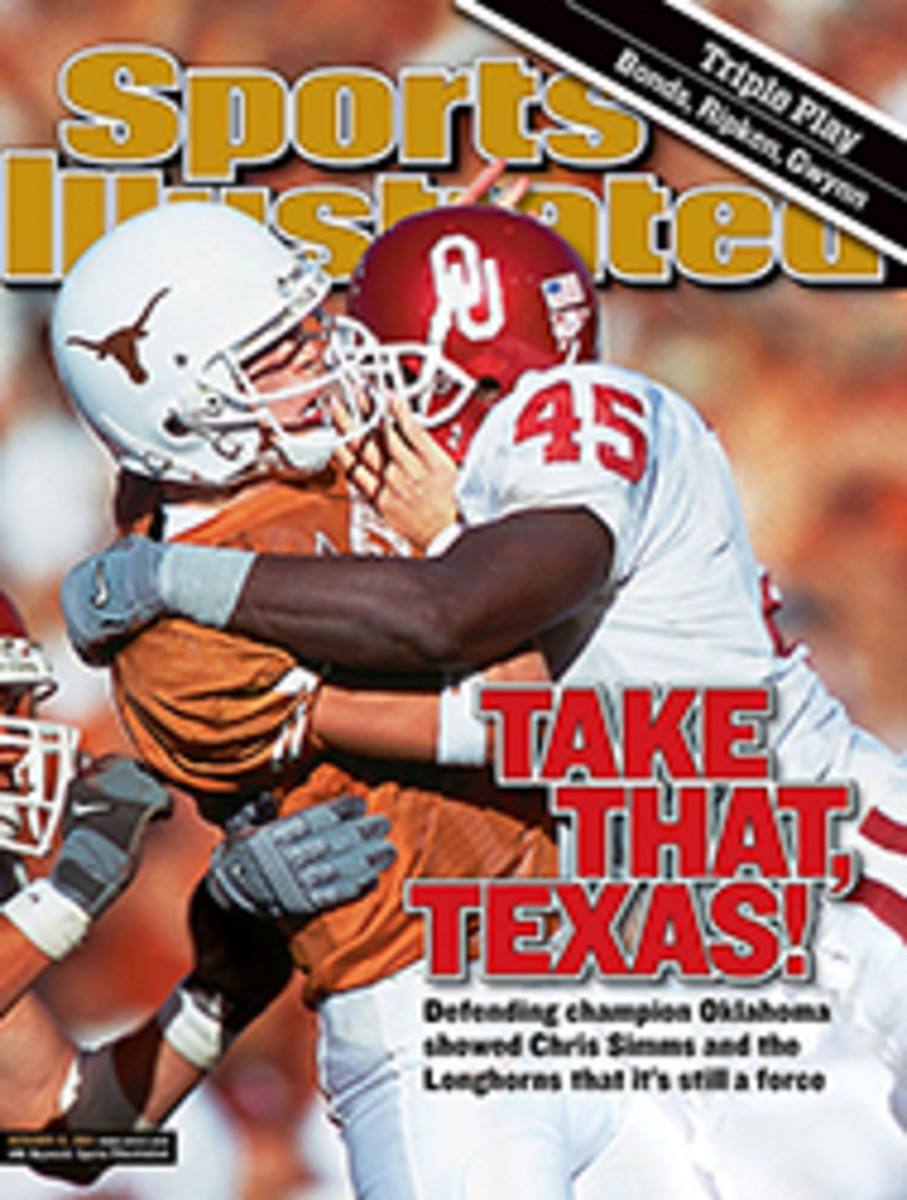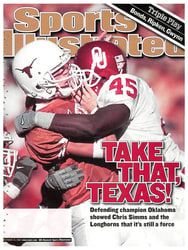
Master Stroke Refusing to be goaded by the blistering bike pace of a brash newcomer, Tim DeBoom used a brilliant late run to win the Ironman championship
Just when does ambition shade into hubris? That's an eternal
question in contests of supreme endurance. When does the innocent
desire to risk a swift pace become such insolence that it goads
gods or fates or natural order to slap you down? As 1,471
athletes from 48 nations gathered last Saturday for the 2001
Ironman Triathlon World Championship on the Kona Coast of Hawaii,
that old question had a new name, and it was Steve Larsen.
The 31-year-old Larsen (SI, Aug. 20) was a cycling teammate of
Lance Armstrong for four years in the early 1990s. "I was the
spin guy with the bird heart," he says. "Lance was the muscle guy
with low rpm's." Larsen, also twice a national champion in
mountain biking, brought to the Ironman's 2.4-mile swim, 112-mile
bike and 26.2-mile run a classic biker's aggressiveness. In
winning his first Ironman only 10 weeks before in Lake Placid,
N.Y., he destroyed the field by 25 minutes on the bike, held on
with a 2:56:53 marathon and won laughing in 8:33:11. He saw no
reason that he couldn't do the same on Kona.
However, Kona is a crucible. Its heat, hills and wind enforce, as
six-time champion Mark Allen puts it, "a purifying humility." Now
retired, the 43-year-old Allen went through years of retching
purgation and postrace emergency-room IVs during the 1980s,
before he learned to propitiate the spirits of the Queen
Ka'ahumanu Highway and pace himself in the lethal conditions.
Larsen, who grew up in the often-searing climate of Davis,
Calif., heard about all that and said, "Hey, the hotter it is,
the better I like it."
Larsen, though, is not a strong swimmer. He knew he would be
coming out of the water long after the other top contenders.
Could he not only catch up on the bike but also break away so
spectacularly that when he reached the concluding stage of the
race, the faster marathoners couldn't run him down? Allen thought
not.
"There is a defined quantity of energy you have to work within to
do this race," said Allen. "I think he'll be surprised at how
hard it is to ride 112 miles here and maintain enough reserve to
run near 2:50 in the marathon. I respect his biking. He could go
27 miles per hour for 80 miles. That'd get a huge gap, but you
have to keep shoveling in fuel for energy and water for cooling,
and that's harder when it's hotter. After six miles of the
marathon, if you haven't conserved, you hold on until 13 and then
you dive-bomb. If he wins this, I'll have to go back to the
drawing board. It would confound my understanding of how all the
elements fit together."
Whether Larsen won or not, he was sure to cause tactical panic.
"The other strong bikers will have fits when he comes by," said
Allen. "They'll all look around and ask, Who's going to go with
him, and who's going to stay? Will I spend too much energy by
going? Will I lose right now if I don't?"
The man whom Allen considered best able to seize that moment was
Tim DeBoom, from Lyons, Colo., who finished third in 1999 and a
close second to Canada's Peter Reid last year. "No man has ever
made me hurt more," Reid said after an epic battle he won by a
little more than two minutes.
DeBoom, 30, soft-spoken, deceptively mild, an Iowa premed
graduate, would be running his ninth Ironman. Over the years he
has become ever more attuned to the hard wisdom dealt out
annually by the Kona course. The transition from the much shorter
Olympic triathlon races took years of long runs and climbs to
14,255 feet up Longs Peak in Colorado. He studied the
preparations of past champions, and in 1998 he trained with Reid
in Boulder. Ratchetlike, he had risen from 145th in his first
race, in '92, to last year's runner-up finish. "Getting second
forced some kind of change in me," he said. "I never look at what
other people are doing anymore."
DeBoom found himself at Kona this year trained to a peak and
worried only about worrying. "I still fight prerace nerves," he
said before the race. "I still haven't run Hawaii knowing I can
win."
The vast field exhibited more bonhomie than tension as the
entrants swam out past a few green sea turtles to the start. The
gun changed all that. The strokes of the leaders were sure and
clean, but the pack's thousands of arms beat the ocean until it
seemed a great net was hauling up tons of flailing salmon. Being
pummeled in there was Steve Larsen.
The leading swimmer, Jan Sibbersen of Germany, did the 2.4 miles
in 48:51. Top contenders DeBoom, Lothar Leder of Germany and
Cameron Brown of New Zealand were out in 52:01, 52:08 and 52:16,
respectively, and had been biking through town for eight and a
half minutes before Larsen finally escaped the clawing sea in
1:00:45 and gave chase.
DeBoom, however, was more worried than ever. The rule prohibiting
drafting says that if passed, one must quickly drop five bike
lengths behind. Early on in the leg DeBoom was flagged by race
officials with a red slash across his number for taking too long
to do that (two slashes and you're out of the race). "I thought
it was a bad call," he said, "but mainly I thought, Crap, what do
I do now?" That was because his penalty required that he stew in
the sin bin for three minutes following the bike leg before he
could begin the run. He had just put himself back in Larsen's
range.
Larsen, riding uphill, loose-jawed, grinning a big white grin,
quickly gained a minute on the leaders. Then, in becalmed air, he
stopped moving up. Two hours into the race he was still seven
minutes down. Roughly 15 miles into the biking leg, the riders
left the protection of Mount Hualalai, which served as a buffer
to the northeast trade winds. "From now to the next moment," said
Normann Stadler of Germany, "it was a wall. Then three walls."
Fifty-mph gusts came down from 13,796-foot Mauna Kea, shifting
from side to side at each new hollow or rise. Defending women's
champion Natascha Badmann of Switzerland, riding on the far
right, encountered one blast and was driven across the entire
road to within a foot of going down into black, razor-sharp a'a
lava. "It was frightening," she would say. But Badmann shrugged
it off and regained her insouciant confidence. Soon she was
hurling herself down the hills with abandon. After the race
eight-time champion Paula Newby-Fraser of California would ask
Badmann her downhill secret. "I don't have one," she'd say. "In
Switzerland we have mountains. You go up, you go down."
The men were being thrown all over the road too, and it was here
that Larsen revealed how superior his biking talent was. Smoothly
spinning, he made up seven minutes and took the lead at 90 miles.
The expected tactical crisis didn't happen. "He went by like a
motorcycle," said Stadler. "We watched him and went back to what
we were doing. He is a beautiful rider."
Smoothly powering through the last 22 miles, riding a tailwind
and a huge 56x11 gear, Larsen hit the transition area some five
minutes ahead of Stadler, about seven ahead of Reid and roughly
10 ahead of the penalized DeBoom. DeBoom had a lot of people
telling him that stretching and cooling in the penalty box can be
an advantage. Newby-Fraser did it in 1996, and she won. "But it
doesn't do much for your mentality," said DeBoom. "A lot of this
is fighting down doubts."
Once he finally began the run, DeBoom showed he had a lot in
reserve. All eyes turned to Larsen. Could he hold on? He had
begun the run tentatively, his expression devoid of smiles. While
it seemed that the elements had done Larsen's bidding, assisting
his biking with the gales and then cooling the course with a
canopy of cloud, they weren't enough. Gradually DeBoom ran him
down. "I put my faith in my running," said DeBoom, "and it was
justified."
He caught Larsen at the 10-mile mark and drove lightly past. The
prerace words of Allen were enacted with amazing precision.
Larsen's hamstrings stiffened at 13 miles, and he slowed to
finish ninth, in 8:56:28. He crept his marathon in 3:19:09. Even
if he'd equaled his performance at Lake Placid, he would have
been nearly three minutes behind DeBoom. As he ran, ever more
ashen and grim, it was tempting to see him as a man who had been
nailed by the universe for his gall in thinking he could
revolutionize this race that eats iron men. Perhaps he was.
Still, his crazy-brave attempt seemed noble, too. He has years to
learn to stay within himself, and to swim.
DeBoom had to hold together because New Zealand's Brown, a
wonderful runner, was charging hard. The crowd, as cosmopolitan
as they come, howled for DeBoom, for the American. "September 11
was on everyone's minds," he said. "I got so much support out
there from both the U.S. and foreign athletes. It meant more to
win it as an American."
Indeed, two nights before, the whole field had lit candles and
held them up during an invocation that urged them to burn for the
lost, burn for life. Be assured that these iron men and women
took that to heart. These are, after all, people we recently
thought of as zealots.
Holding up an American flag in joy, DeBoom finished in 8:31:18,
more than 15 minutes ahead of Brown. The first U.S. victor since
Allen in 1995, DeBoom was crowned with maile leaves and embraced
by Allen and by his sobbing mother. But he had to wait for his
wife, Nicole, until she finished 13th in the women's race, which
Badmann easily won in a wind-slowed 9:28:37. "It is so satisfying
to be a part of the elite group who have won this race," DeBoom
said, "that I almost feel like I could hang it up right now. I
won't, of course. I'd miss the training. I love the training."
But the racing? "I was tired," he said. "I suffered as much as
anyone. Every year I think it might be better, and it's always
worse. It's always worse."
COLOR PHOTO: PHOTOGRAPH BY ROBERT BECK Ocean commotion The Kona Coast turned into a surging sea of humanity during the 2.4-mile swim, the first leg of the prestigious championship.
COLOR PHOTO: ROBERT BECK Road hazard Wind gusts of up to 50 mph threatened to hurl bikers into the razor-sharp volcanic rock that lined much of the 112-mile stretch.
TWO COLOR PHOTOS: TRACY FRANKEL (2) Run down On bike Larsen blew past the field, but on foot he was eventually passed by the three-dimensional DeBoom (bottom left).
COLOR PHOTO: ROBERT BECK Finishing touch With the multinational crowd united behind him, DeBoom became the first U.S. victor since Allen in 1995.
Kona is a crucible. Its heat, hills and wind enforce, as six-time
champion Mark Allen puts it, "a purifying humility."
While it seemed that the elements had done Larsen's bidding,
assisting his biking with the gales, they weren't enough.
"September 11 was on everyone's mind," DeBoom said. "It meant
more to win it as an American."

